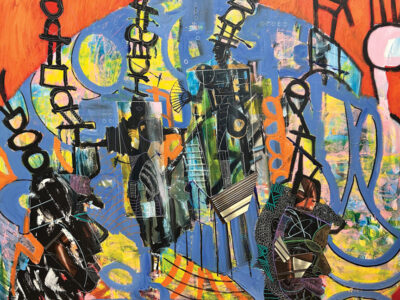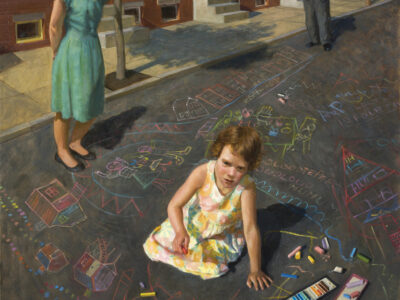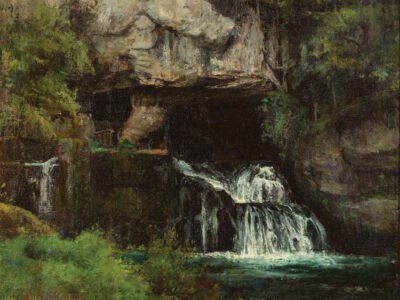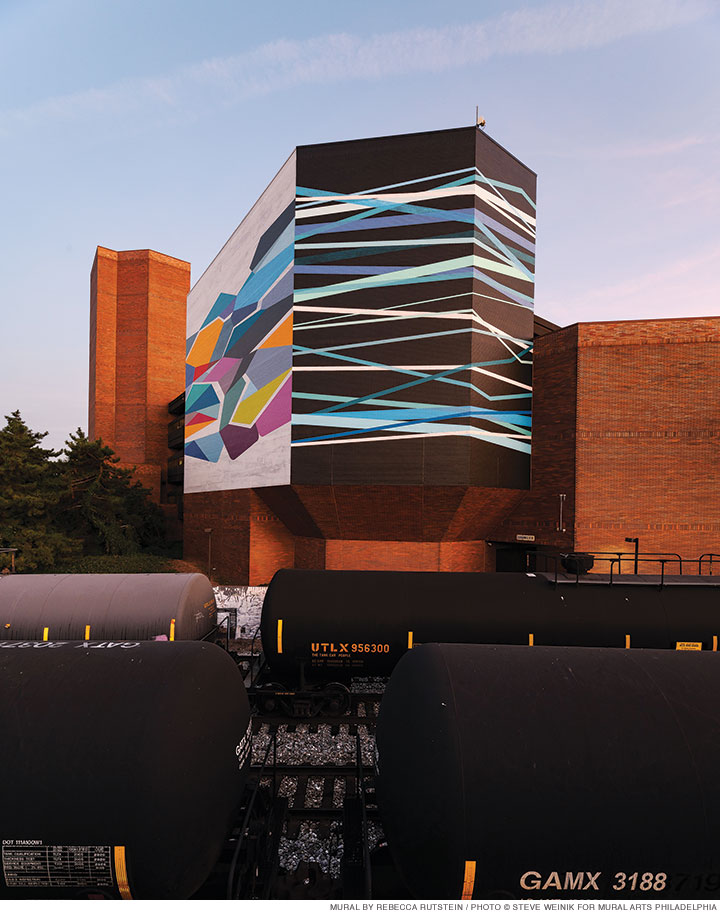
From an urban riverscape to the ocean floor, Rebecca Rutstein’s art leaps beyond the gallery walls.
A few years ago, Rebecca Rutstein GFA’97 stood on the roof of Philadelphia’s fortress-like AT&T Building, a red-brick behemoth that rises seven stories above the east bank of the Schuylkill River, and surveyed her surroundings. The artist took in the gleaming glass towers of University City and Center City, the tangle of highways and bridges, and the Schuylkill’s gentle bends.
This summer the building’s river-facing blank brick façade became the canvas for a 7,800-square-foot diptych mural Rutstein titled Convergence. The first part, an orderly composition of vividly hued polygons (astute observers will spot echoes of the lime and raspberry tones that appear in nearby graffiti), is inspired by the offerings of fruits and flowers that are tossed into the river during Philadelphia’s African American Odunde street festival. The second part, all moody blues and grays, is an abstraction of the water currents and the criss-crossing roads.
“So much comes together here,” Rutstein says of the site, adding that the piece, which was dedicated in late October as part of the citywide Mural Arts program, “ties into the rest of my work and my interest in geology, the fractals found in nature, and the complexity of systems.”
Rather than starting from a vantage point above it all, though, Rutstein more typically dives beneath the surface. Like, really deep: twice so far, she’s accompanied marine scientists to the ocean floor in the Alvin, the US Navy’s flagship research submersible, which is operated by the Woods Hole Oceanographic Institution. She was invited to produce work that “shares the visual experience of what’s going on beneath the ocean,” she says.
A Philadelphia-area native, Rutstein, 48, traces her fascination to an epiphany she had during an artist residency in Hawaii.
“I went on a helicopter ride, I went tubing, I went hiking amid lava flows,” she says. “One day I came across sonar maps of the ocean floor. I could see the mountains that would one day become the next island and I became aware of this whole other world.” Shortly thereafter, she came across an obituary of geologist Marie Tharp, who in the 1950s used data collected from sonographic readings to create the first maps of the Atlantic Ocean floor. Rutstein’s artistic trajectory was sealed.
In 2015, she started joining expeditions at sea—journeys that took her from Galapagos to San Diego, from Vietnam to Guam, to Costa Rica and the Sea of Cortez. Her canvases bloomed with abstractions. Consisting of squiggly lines or amorphic blobs, some of the works are wildly colorful, some are overwhelmingly blue. Some are pulled back, some are tightly focused. It’s impossible to discern which is which, and Rutstein prefers it that way. “You can’t tell if what you’re looking at is a microscopic image of archaea or a macro image of the ocean floor taken by sonar,” she says. “I like that ambiguity of scale.”

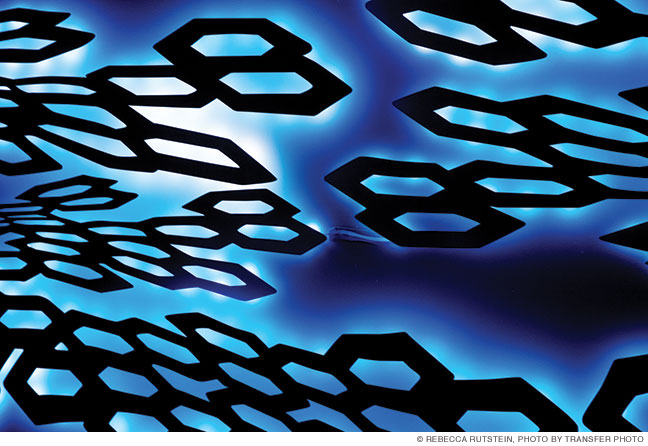
As she’s made her work and interests known, she’s been granted the rare opportunity to descend in the submersible. “The most compelling thing about being on the Alvin, besides being at the bottom of the ocean,” she says, “was the passage through the water column, and seeing the change from complete blackness to these incredible glowing orbs everywhere. That has definitely shown up in my work.”
Take Shimmer, a 64-foot-long steel sculpture that’spart of a year-long exhibition at the Georgia Museum of Art, which was inspired by an Alvin descent she made with University of Georgia professor Samantha Joye. Equipped with motion sensors that cause programmed LED lights to flicker in response to the movement of the viewer, the piece offer’s Rutstein’s interpretation of the actions of a siphonophore, a bioluminescent organism. In collaboration with Erik Cordes, a vice chair of biology at Temple University, and Christine Lee, an artist who uses discarded materials like wood shims and scrap lumber, Rutstein plans to take this concept further in The Immersion Project, which she calls a “large-scale, interactive land-to-ocean installation.” Inspired by coral formations, bioluminescence, and deep sea acoustics, the work will feature sculptures made from 3D-printed sustainable materials that will rise from the floor and fill the space in dense, monumental clusters. At the end of the traveling exhibition, the installation will be placed in the Gulf of Mexico as an artificial reef—bits of which will intentionally dissolve to deliver embedded nutrients to support regeneration and biodiversity—as part of restoration efforts associated with the Deepwater Horizon Oil Spill of 2010.
“What I’m most excited about now,” Rutstein says, “is broadening my practice so that the work resonates beyond aesthetics. There’s the continued merging of art and science, combined with a bigger message about ecology and the fragility of the ocean, but also the chance to work with other artists like sound engineers, fabricators, and video programmers. Who knows where I’ll be three years from now. Maybe outer space?”
—JoAnn Greco


